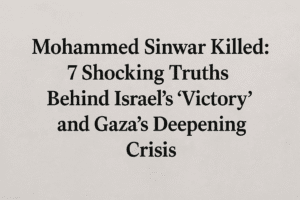Mohammed Sinwar Killed: 7 Shocking Truths Behind Israel’s “Victory” and Gaza’s Deepening Crisis
Israeli Prime Minister Netanyahu’s announcement of Mohammed Sinwar’s death marks a significant but complex moment in the ongoing Gaza conflict. Sinwar, a key Hamas figure managing operations inside Gaza, was a central target in Israel’s efforts to weaken Hamas’s leadership amid a brutal 20-month war. While Israel portrays this as progress in dismantling Hamas, the cycle of leadership losses and replacements continues, highlighting the limits of military action. Meanwhile, Gaza’s humanitarian crisis worsens, with tens of thousands killed, severe shortages of essentials, and widespread civilian suffering overshadowed by strategic narratives.
The hostage situation remains unresolved, intensifying domestic pressures in Israel and complicating ceasefire talks. Despite tactical gains, the deeper political issues—occupation, Palestinian rights, and long-term peace—remain unaddressed. This announcement underscores a grim reality: military victories fail to halt the enduring cycle of violence and suffering. True progress requires addressing the human and political dimensions fueling the conflict, beyond headline-grabbing kills.

Mohammed Sinwar Killed: 7 Shocking Truths Behind Israel’s “Victory” and Gaza’s Deepening Crisis
Israeli Prime Minister Benjamin Netanyahu’s declaration to parliament that Mohammed Sinwar, a key Hamas leader in Gaza, has been killed, lands amidst a complex and brutal stalemate. While presented as a significant military victory, the announcement raises critical questions about the trajectory of a devastating 20-month conflict and the fate of Gaza’s civilians.
More Than Just a Name on a List:
Netanyahu included Sinwar’s name alongside other high-profile Hamas figures killed since the war began – Mohammed Deif (military chief), Ismail Haniyeh (political leader), and Yahya Sinwar (Mohammed’s brother and the group’s former Gaza chief). Mohammed Sinwar wasn’t the supreme leader in exile (based in Qatar), but he had become a crucial operational figure within Gaza itself. As reported earlier by the Wall Street Journal and acknowledged by Israeli military analysts like Brig. Gen. (ret.) Amir Avivi, Sinwar was deeply involved in managing Hamas activities on the ground, including recruitment and restructuring efforts after heavy losses.
Why This Announcement Now? Context is Key:
- Strategic Narrative: For Netanyahu, listing these names serves to bolster the argument that Israel’s military campaign is systematically dismantling Hamas’s leadership structure, justifying the prolonged offensive despite immense international pressure and humanitarian cost.
- Domestic Pressures: Netanyahu faces significant unrest at home, primarily from families of the remaining 58 hostages held in Gaza. Large protests demand a deal for their release. Announcing high-profile eliminations may aim to reassure a domestic audience of progress and resolve, countering calls for an immediate ceasefire.
- Ceasefire Talks: The announcement comes as U.S. envoy Steve Witkoff expresses optimism about reaching another temporary ceasefire and a “long-term resolution.” Eliminating a key figure like Sinwar could be seen by Israel as strengthening its hand in negotiations, potentially weakening Hamas’s command in Gaza during critical talks. Conversely, it could also harden Hamas’s stance.
- The Relentless Cycle: This death underscores a grim pattern: the elimination of one leader leads to the rise of another within Gaza’s entrenched militant structure. Israel claims to have killed “tens of thousands of terrorists,” yet Hamas continues to recruit and operate, highlighting the immense difficulty of achieving the stated goal of “dismantling Hamas” through military means alone.
The Crushing Human Reality Overshadowed:
While leadership decapitation makes headlines, the human toll in Gaza is catastrophic and ongoing:
- Unfathomable Loss: According to Gaza’s Hamas-run health ministry (the only source available, though casualty figures are contested), over 54,000 Palestinians have been killed. The ministry does not distinguish between combatants and civilians, but the scale indicates immense civilian suffering.
- Humanitarian Catastrophe: The two-month ceasefire that ended in March gave way to renewed intense Israeli strikes and a near-total blockade on aid. Reports of widespread starvation and critical shortages of medicine, fuel, and clean water persist. While limited aid has recently been allowed, it falls drastically short of needs.
- Hostage Anguish: The recent release of Eden Alexander, the last known living American hostage, brought relief but also sharpened focus on the 58 others still captive. Their families’ agony fuels the protests demanding a deal. Netanyahu’s insistence that the war will continue “to the end,” even with potential pauses for hostage releases, offers them little solace.
- Suffering Blamed, Suffering Ignored: Israel consistently blames all hardship in Gaza on Hamas, citing the blockade as pressure for hostage release. However, this policy disproportionately affects civilians, including hundreds of thousands of children facing malnutrition and disease, creating a humanitarian disaster with generational consequences.
Insight: The Value Beyond the Victory Lap
Netanyahu’s announcement is a tactical note in a sprawling, tragic symphony. The killing of Mohammed Sinwar may disrupt Hamas operations in Gaza, but it does not:
- Resolve the Hostage Crisis: The fate of 58 lives remains uncertain and central to any potential deal.
- End the War: Israel vows to continue until it controls Gaza and dismantles Hamas – objectives fraught with immense military and humanitarian challenges.
- Alleviate Civilian Suffering: The blockade and destruction continue to inflict unbearable conditions on Gaza’s population.
- Provide a Clear Path Forward: While the US seeks a “long-term resolution,” the fundamental issues driving the conflict – occupation, security, Palestinian rights, Hamas’s ideology – remain unaddressed.
The real value in understanding this news lies not in accepting it as a decisive turning point, but in recognizing it as another grim marker in a conflict where military actions consistently outpace diplomatic solutions and where the civilian cost mounts relentlessly. The elimination of leaders is a recurring theme; the unending suffering of innocents is the devastating, unchanging chorus. True progress demands moving beyond the cycle of elimination announcements and addressing the profound human and political realities that fuel this enduring crisis.
You must be logged in to post a comment.